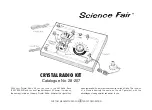
42
58-640 PULSAR Model R96 Pulse Burst Radar Transmitter - F
OUNDATION
fieldbus
™
Instruction Manual
In essence, this approach ensures that the correct diagnostic
information is available to the correct person-at the correct
time. In addition, it allows diagnostics to be applied, as
most appropriate, for a particular plant application (such as
process control engineering or asset management mainte-
nance). Customer specific mapping of diagnostics to these
categories allows for flexible configuration depending on the
user's requirements.
From an external Model R96 transmitter perspective, diag-
nostic information includes measurement of process condi-
tions, in addition to detection of internal device or system
anomalies.
As mentioned above, the indicators can be assignable (via
the DTM or host system) by the user to any (or none) of
the NAMUR recommended Status Signal categories:
Failure, Function Check, Out of Specification, and
Maintenance Required.
The F
OUNDATION
fieldbus version of the Model R96 trans-
mitter was implemented according to the Field Diagnostics
Profile, which is consistent with the objectives of NE 107.
In the F
OUNDATION
fieldbus version, diagnostic indicators
can be mapped to multiple categories, an example is shown
in the diagram at left.
In this example, “Calibration Required” is mapped to both
the Out of Specification and Maintenance Required status
signals, and the diagnostic indicator named “High
Electronic Temperature” is mapped to none of the signals.
Indicators that are mapped to the Failure category will nor-
mally result in a bad status indication.
A default mapping of all diagnostic indicators will be applied
initially, and can be re-applied through use of a restart with
defaults operation.
No Fiducial
Echo Lost
Calibration
Required
Failure
Function
Check
Out of
Specification
Maintenance
Required
NE-107
Status Signals
Diagnostic Indicators
High
Elec Temp
















































